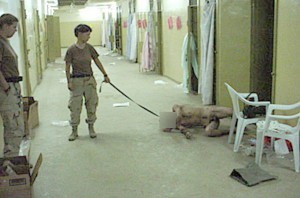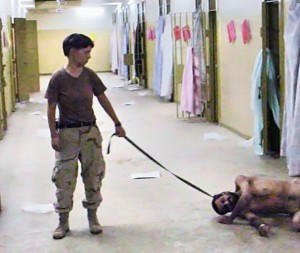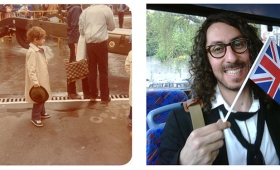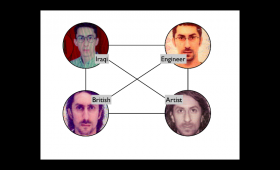They are not having fun.
I can’t have fun if they don’t.
If I get them to have fun, then I can have fun with them.
– R.D. Laing, Knots
The images of torture from Abu Ghraib Prison were first broadcast and published in the spring of 2004.[1] What these images revealed horrified and shocked the world and a lot has been written about them in the press, books and Internet weblogs with regards to the Geneva Convention violation of the acts of torture and the pornographic style of the images.
It is common for psychoanalytic practice to look for the hidden referent of sexuality, but in these images, sexuality is plainly apparent. According to Žižek, where there is an overtly sexual expression, “one has to look for another meaning.”[2] It is this “another meaning” in relation to the role of fantasy in looking at a photograph that this paper explores.
The paper takes one of the images and analyses it, outside of its journalistic context, as a constructed scene. The aim is not to attenuate the torture and abuse revealed in the image, nor is it to question the reality behind the captured ‘moment’, but rather to view the image in the light of Western art’s tableau vivant. Stephen F. Eisenman argues that despite the wide coverage of the images in the media, “[n]o one has addressed in any depth or with any specificity what is actually depicted in the photographs, that is, their basic organisation of bodies and mise-en-scène.”[3]
The paper also investigates the fantasmic properties of the image for the Western gaze.[4] The analysis of the image adopts concepts from different Lacanians in their analysis of the gaze and its relation to fantasy. And because of the tableau vivant nature of the images, the argument also borrows from the cinematic and film theories.
The image chosen for this analysis is of a female soldier holding a leash attached to a naked man’s neck. (Image 1)
 The leash occupies the centre of the image. On one end of the leash a female soldier is holding it in the clenched fist of her left hand. Her right arm is hanging next to her body with her right hand semi-open and turned inward. She has a boyish look with short hair. She is wearing a khaki t-shirt and combat trousers and boots. Her face is turned to her left and her gaze leads towards the other end of the leash where it is attached to a man’s neck. The man is completely naked and lying on the floor on his right side. His right arm is stretched forward while his left arm is bent in front of him and his left hand is under his face as if he is trying to push himself up. The man’s body is lean and despite the look of torment on his face, his hair looks tidy and his beard is trimmed.[5] His thighs are spread open revealing his genitalia but his legs meet again at his feet, forming a spade shape with his legs. He seems to have emerged from (or been dragged out of) the cell with the open door on the right side of the image.
The leash occupies the centre of the image. On one end of the leash a female soldier is holding it in the clenched fist of her left hand. Her right arm is hanging next to her body with her right hand semi-open and turned inward. She has a boyish look with short hair. She is wearing a khaki t-shirt and combat trousers and boots. Her face is turned to her left and her gaze leads towards the other end of the leash where it is attached to a man’s neck. The man is completely naked and lying on the floor on his right side. His right arm is stretched forward while his left arm is bent in front of him and his left hand is under his face as if he is trying to push himself up. The man’s body is lean and despite the look of torment on his face, his hair looks tidy and his beard is trimmed.[5] His thighs are spread open revealing his genitalia but his legs meet again at his feet, forming a spade shape with his legs. He seems to have emerged from (or been dragged out of) the cell with the open door on the right side of the image.
A second female soldier occupies a very narrow space in the extreme left of the image. She seems to be only witnessing the scene. This is apparent from her passive hand-in-pocket gesture and her leaning back against the wall. Like the other soldier, she is wearing a khaki t-shirt and combat trousers. Her gaze is also leading towards the naked man on the floor. She is in the foreground of the image, closer to the front of the image than the first soldier but her presence is marginalised by her position on one side of the image, partly cropped.
The foreground of the image is busy with clutter. There are two white plastic chairs on the right side covered and surrounded with rubbish and debris. On the left side of the image, where the second female soldier is standing against the wall, there are three cardboard boxes filled with objects.
The space of the image is a corridor with cells (or rooms) on both sides. There are pieces of paper and plastic bags scattered on the floor along the depth of the corridor. Most of the cells doors on the left side are closed except for the last two at the far end which are partly open. The first door on the right side, where the naked inmate seems to have been dragged out from, is wide open revealing the darkness of the cell – like a black hole. Except for the first cell, which has a door, all the other cells on the right side have gates with bars – the only indication in the image to the prison space. Some of the gates are closed and covered with curtains made out of colour bed sheets. The other gates are open and have the colour bed sheets hanging on their bars – these bed sheets offer a break in colour to the otherwise monotonous image. Hanging on the wall next to each cell there is a bright red square, which could be a red light fittings.
 But this is not exactly how this image was broadcast and published. Whether it was for damage control or aesthetic reasons, the image was cropped (image 2). What the crop removes are the cluttered foreground (boxes and chairs), the lower half of the naked inmate’s body (including his exposed genitalia) and the second female soldier on the left margin of the image. The crop functions as a close-up. It brings the scene closer to the voyeur. What remains after the crop are the essential factors of the torture: the deserted prison corridor with its cell gates, the upper body of the naked inmate and the female soldier holding the leash.
But this is not exactly how this image was broadcast and published. Whether it was for damage control or aesthetic reasons, the image was cropped (image 2). What the crop removes are the cluttered foreground (boxes and chairs), the lower half of the naked inmate’s body (including his exposed genitalia) and the second female soldier on the left margin of the image. The crop functions as a close-up. It brings the scene closer to the voyeur. What remains after the crop are the essential factors of the torture: the deserted prison corridor with its cell gates, the upper body of the naked inmate and the female soldier holding the leash.
The corridor offers the spectator a perspective. Catherine Belsey argues that “[p]erspective gives, then, and it takes away. It gives the miracle of a simulated reality so palpable that we might be there […] At the same time, perspective narrows that reality to a moment already lost […], so that, conversely, we cannot be there.”[6] This distinction between the spectator’s presence and absence in the image forms what Todd McGowan describes, in terms of the gaze, as the separation of Desire and Fantasy, or the ‘cinema of intersection’. He argues that this separation “involves bringing the cinematic depiction of an experience of desire (where the gaze is absent) and an experience of fantasy (where the gaze is a distorting presence) into the same film and sustaining a separation between them in order to reveal what occurs when they collide.” He further explains, “as spectators, we encounter an object that does not fit within the filmic field of representation and yet by that very fact indicates our involvement in that field.”[7]
The cells gates on the right not only give the image depth, but also a sense of repetition. This repetition might suggest similar acts to what the spectator is witnessing – acts which might have happened just before or will happen soon after (the open gates and the cluttered floor might hint towards the former.) This depth is eventually closed, it is closed by a wall; and as though to suggest that there is nothing more that the spectator can or is allowed to see behind this wall. This closure of the depth means that the only way out of the image is through the front where the spectator is standing. Not only that the perspective gives the spectator a space in the image, but this closure of the space at the back places him/her as the gate keeper and gives the spectator the control of whom to be allowed out of this scene.
If the purpose of cropping the naked prisoner’s body from the waist down were merely to remove his genitalia for damage-controlled consumption, then a simple blurred square, similar to that used to cover his face, would have been adequate. But this exclusion of details (including the flaccid penis) from the original scene is exactly what keeps the image from falling into the pornography genre, which is known to “reveal all there is to reveal.”[8] Roland Barthes describes both the journalistic and pornographic photographs as “unary”. He describes the pornographic photograph as “naïve” and “without intention and without calculation.” Similar to the news photographs where he writes, “I am interested in them (as I am interested in the world), I do not love them.”[9] He further exemplifies the shift from the pornographic to the erotic in Mapplethrope’s close-ups of the of genitalia “by photographing the fabric of underwear at very close range: the photograph is no longer unary, since I am interested in the texture of the material.”[10]
The prisoner is no longer a “revealing all” subject but has become a torso, an object of the gaze, an objet petit a. Todd McGowan defines the gaze as “the objet petit a of the scopic drive (the drive that motivates us to look)”, he further describes the objet petit a as “a is a lost object, an object that the subject separates itself from in order to constitute itself as a desiring subject […] As such, it acts as a trigger for the subject’s desire, as the object-cause of this desire, not as the desired object.”[11] The gaze promises to reveal the secret of the lacking other, but this secret exists only as long as it remains hidden. The full naked body possesses no secrets, and hence offer the gaze nothing no uncover.
The female soldier holding the leash is standing in the middle of the corridor. She is acting as the executer of the torture, the one in control: the sadist. Her gaze is turned to her left and downwards at the naked man. On the surface, the image can be read as a symbol for femininity and the desire to tame the masculinity of the terrorists: West versus East; Americanism versus Islamic Fundamentalism; Femininity versus Sexism.
“For the female spectator”, Mary Ann Doane writes, “there is a certain overpresence of the image – she is the image.” [her emphasis] She adds, “the female spectator’s desire can be described only in terms of a kind of narcissism – the female look demands a becoming.”[12] If the female fantasy is to torture the male, then this “becoming” in this image will have a traumatic impact on the female spectator. According to Freud: “If what [subjects] long for most intensely in their phantasies is presented to them in reality, they nonetheless flee from it,”[13] which Žižek further explains that this is because “the core of our fantasy is unbearable to us.”[14] Meaning that if the female spectator is to identify with the female soldier, this abolishes her fantasmatic screen, in which case the image will shatter her reality. Doane distinguishes between two types of female spectatorship; “the woman who identifies with a female character must adopt a passive or masochistic position, while identification with the active hero necessarily entails an acceptance of what Laura Mulvey refers to as a certain ‘masculinisation’ of the spectatorship.”[15]
Therefore, identifying with the hero of this image, requires the female spectator to adapt a masculine gaze. In other words, She should not position herself as the female soldier, but rather as the other.
The female soldier in the image is no more than a vehicle for an other’s desire. According to Žižek, “the desire staged in fantasy is not the subject’s own, but the other’s desire” [his emphasis].[16] Victor Burgin goes even further in explaining the role of the other in fantasies; he writes: “The White male racist who fantasizes a White woman’s rape by a Back man might be seen as defending himself against his own aggressive sexual impulses. He represses the fantasy in which he himself is a rapist; the emotional investment in the unconscious fantasy forces it back into consciousness but now in an acceptable disguise: the rapist is identified as Black, absolving the subject of the fantasy of any culpability in the imaginary crime.”[17] In these two quotes, Žižek’s subject is Burgin’s Black male and the other is the White male: the Black male is not there for his own fantasy, but is only an other for the White male’s fantasy. If applied to the Abu Ghraib image, it is not the female’s fantasy to torture the male, but instead, it is the fantasy of the other, who, in the Abu Ghraib image, happens to be, again, the White male.
The fact that the scene was photographed indicates the presence of spectatorship beyond those who are acting in it: there is no point of the pose if there is no camera, likewise, there is no point of the camera if there are no spectators. The resemblance of the image to works of art by celebrated contemporary visual artists is uncanny.[18] George Neumayr writes: “Had Robert Mapplethorpe snapped the photos at Abu Ghraib, the Senate might have given him a government grant.”[19] Writing about the Abu Ghraib photographs, Susan Sontag argues that enacting fantasies of violence has become an act of entertainment in the American culture, she writes: “America has become a country in which the fantasies and the practice of violence are seen as good entertainment.”[20]
In Michael Haneke’s film Funny Games (Austria, 1997), the role of the spectator as an accomplice to the two middle-class boys in their torture of a family is a key point in the film narrative. At different points in the film, Paul (Arno Frisch), the mastermind of the torture, turns to the camera and engages the spectators in his games indicating that they, too, are enjoying these games. The point that Haneke makes echoes what Sontag argues; that torture of the other has become “good entertainment” and through the spectator’s obsessive gaze, s/he is already identified with the torturers. This identification, Žižek argues is “on the level of the gaze, not on the level of the content.”[21]
The repeated publication and broadcast of the image through all sorts of visual channels (TV, newspapers, magazines, Internet websites) forced spectators to experience what Žižek describes as “the compulsion to repeat.” He further argues that the “uncanny satisfaction” spectators get from the repetition of images of horror is “jouissance at its purest.”[22] Jouissance, according to Lionel Bailly’s interpretation of Lacan, is “the pleasure that comes with the functioning of the physical or psychological apparatus associated with a drive.” Unlike pleasure, Jouissance does not reduce tension but it is “the enjoyment of a sensation for its own sake, and is linked with the death drive, which goes beyond the pleasure principle.”[23] One wants to see the image again, identify with a gaze and look for more images. But the need is never satisfied nor the there is a relief to the tension. There is no pleasure in this pursuit, there is only jouissance.
The fact that images of torture existed in Western art and popular culture before this image was taken at Abu Ghraib prison proves the paradox that such obscenity is only an enactment of the fantasy. Žižek explains Lacan’s notion of ‘traversing the fantasy’ as “the concluding moment of the psychoanalytic treatment.” He continues: “In our daily existence, we are immersed in ‘reality’ (structured and supported by the fantasy), and this immersion is disturbed by symptoms which bear witness to the fact that another, repressed, level of our psyche resists this immersion. To ‘traverse the fantasy’ therefore, paradoxically, means fully identifying oneself with the fantasy – namely, with the fantasy which structures the excess that resists our immersion in daily reality.” [his emphasis][24]
It is exactly this “identifying oneself with the fantasy” what marks the twenty first century’s with its Reality TV and ‘i’ nation (iPhone, iPlayer). If we can accept Žižek’s perception of the collapse of the World Trade Centre towers on 11 September 2001 as “the climatic conclusion of the twentieth-century art’s ‘passion for the Real’”,[25] then we can perceive the Abu Ghraib Prison image as the foreplay of the twenty-first century art’s ‘traversing the fantasy’.
The image rubs elbows with today’s art and its tableau vivant precisely for its staging of the fantasy. Regardless in which visual art genre one places the image, it remains a representation of some sort of reality. The image entered reality through enacting the unthinkable. By offering the spectators a traumatic encounter with the gaze, the image is able to shock. By posing a question, Žižek confirms the importance of contemporary art in its expression of the inexpressible; he writes: “And is this not the ethical duty of today’s artist […] to stage fantasies that are radically desubjectivized, that cannot ever be enacted by the subject?”[26] And this is exactly what the image of the Abu Ghraib has become: an image, a notion of the real, which represents the real thing itself.
Notes:
[1] Gourevitch, Philip and Morris, Errol (2009) Standard Operating Procedure: A War Story, Basingstoke and Oxford: Picador, previous publication 2008, New York: Penguin. p 262
[2] Žižek, Slavoj (2006) ‘From Che vuoi? To Fantasy: Lacan With Eyes Wide Shut’ in How to Read Lacan, London: Granta Books. p 51
[3] Eisenman, Stephen F. (2007) The Abu Ghraib Effect, London: Reaktion Books Ltd. p 30
[4] The topic of the Eastern or Oriental gaze can be a subject of another paper where a through a study of the Orient or Eastern gaze needs to be studied and the representation of torture in Eastern art history.
[5] These descriptions are from the cropped image where the man’s face is not covered by a blurred square.
[6] Belsey, Catherine (2005) ‘Desire and the Missing Viewer’ in Difference and Culture, London: Routledge. p 100
[7] McGowan, Todd (2007) ‘The Separation of Desire and Fantasy’ in The Real Gaze: Film Theory After Lacan, Albany: State University of New York Press. p 163
[8] Žižek, Slavoj (1991) ‘Pornography, Nostalgia, Montage: A Triad of the Gaze’ in Looking Awry: An Introduction to Jacques Lacan Through Popular Culture, Cambridge and London: MIT Press. p 109
[9] Barthes, Roland (1993) Camera Lucida, London: Vintage Books, first published in French, 1980; previous English publication 1981, New York: Hill and Wang. p 41
[10] Ibid. pp 41-2
[11] Ibid 6. p 6
[12] Doane, Mary Ann (1991) ‘Film and the Masquerade: Theorising the Female Spectator’ in Femme Fatales: Feminism, Film Theory, Psychoanalysis, London: Routledge. p 22
[13] Ibid 2. pp 55-56
[14] Ibid.
[15] Ibid 11. p 24
[16] Ibid 2. p 48
[17] Burgin, Victor (1996) ‘Paranoiac Space’ in In/Different Spaces: Place and Memory in Visual Culture, London: University of California Press, Ltd., p 134 18 Not only contemporary art, but also resemblance to images in the history of Western visual culture can also be found. One example is the section in the Great Altar of Pergamon freize (c. 180-150 BC) which depicts the torture of Alkyoneus by the goddess Athena with a snake wrapped around his naked body.
[19] Neumayr, George, ‘The Abu Ghraib Collection.’ American Spectator Online, 12 May 2004. http://spectator.org (accessed on 26 December 2010)
[20] Sontag, Susan, ‘Regarding the Torture of Others.’ The New York Times Online, 23 May 2004. http://nytimes.com (accessed on 26 December 2010)
[21] Ibid 7. p 108
[22] Žižek, Slavoj (2002) ‘Passion of the Real, Passions of Semblance’ in Welcome to the Desert of the Real, London and New York: Verso. pp 11-12
[23] Baily, Lionel (2009) Lacan: A Beginner’s Guide, Oxford: Oneworld Publications. pp 118-119 24
[24] Ibid 22 p. 17
[25] Ibid 22 p. 56
[26] Ibid 2. p. 57



